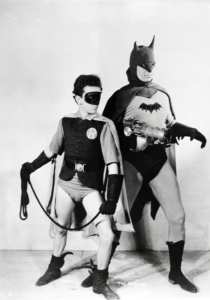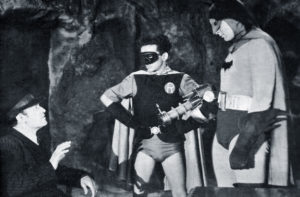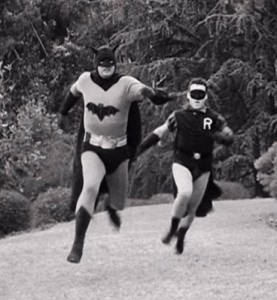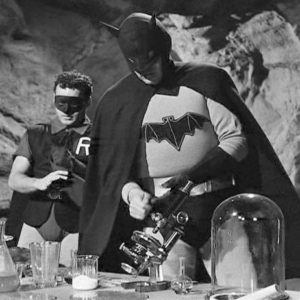Two Saturday-morning theatrical serials of Batman were produced in the 1940s, and it’s hard to overestimate the influence they had on the character. After all, Hugh Hefner showed these serials at the Playboy mansion and crowd response led to ABC putting on the Batman television show. Not only that, it was the 1943 movie serial, Batman, that introduced the idea of the Batcave which was entered through a grandfather clock in the house (never referred to as Wayne Manor in either serial).
But when you look at the dates of the serials – 1943, 1949 – and the costumes – Batman doesn’t have the circle around the bat on his chest – it would be fair to say the Batman in the two serials is the Batman of Earth 2.
It was this Batman who came out in Detective Comics in May 1939. A year later, Robin was added to the mix and sales doubled. Three years later the movie serials started coming out. I don’t know the lead time between the decision of Columbia Pictures to make a serial out of this guy, to negotiations, to production, to screening, but if it was a year, that means that within three years of Batman starting, within two years of Robin’s debut, they decided to make a movie serial out of him. That’s impact.
Again, it’s 1943, they had dozens of heroes to choose from even within DC. And they kept the baseline of the story of Bruce Wayne. By contrast, Republic changed anything they wanted about Captain America. DC, of course, looked at the SUPERMAN animated series from Fleischer (which came out in 1941) and thought a good thing would be had by all. Try and do that with Twitter.
The series was made in 1943 and that has made it age badly. References to “Nips” and “Japs” grate now, but it was unavoidable within two years of the sneak attack on Pearl Harbor where 2402 Americans were killed. Also to be condemned was the gratuitous slur on African Americans when Bruce Wayne says he hasn’t seen someone “in a coon’s age.”
However I note the chief Japanese villain doesn’t talk about how he likes to do evil, he calls the democracies evil, says America is corrupt, and that he is fighting for a new world order.
Also, Columbia Pictures don’t seem to have known what the hell they were doing. There are a number of discontinuities of plot and characterization. As if they were writing this on the fly. For example, Bruce Wayne is established as so lazy he doesn’t get up before noon, but soon after is fully ready to send his car after a car full of crooks.
The series made several changes from the comics. For a start, in the comics at this time, Robin was eight years old. The actor who played Robin, Douglas Croft, was 17. In what would become a tradition that would be used in the next serial and the television series, he would wear tights to imitate Robin’s bare legs. In another tradition-in-waiting, Robin loses fights. In the forties, though, he didn’t just get threatened with damage, he got knocked out a lot. How often? Play a drinking game: Dick Down. Every time Robin is knocked down and stays there, take a drink and you will find out you are not drinking responsibly.
There was no Commissioner Gordon in this series, it was a Captain Arnold who ran the Gotham City police force. And Bruce’s girlfriend is Linda Page, who never appears in the comic. I guess it’s like Rachael Dawes in Batman Begins and The Dark Knight. Linda was played by Shirley Patterson who would later achieve bigger things in the fifties when she was known as Shawn Smith.
It’s a little strange because near the end of the serial, she’s suddenly his fiancě. We don’t see any proposal so I guess that’s like Burton letting Vicki Vale into the Batcave without us seeing anybody tell her what’s going on. In the serial, when Linda suddenly becomes engaged, Batman has his gloves off and the actor, Lewis Wilson, still has his wedding ring on.
There is no Wayne Manor, just a house over a little cave with a desk in it. The Batmobile is Bruce Wayne’s convertible with the top up. Alfred is a silver-haired man as he has been in every television show and movie for the last 70 years. In live action, Alfred has always been a generation older than Bruce Wayne, and he has never been the balding, dark haired man he is in the comics. And in the comic he never wears glasses, which he wears here and apparently handed down to the Alfreds of the TV series and the Burton/Schumacher movies.
Batman’s costume is, well, terrible. He looks like retiree Batman with trunks that high. The cape is much shorter. The cowl I think was adapted from a Halloween costume because those look like horns, not bat ears. I seriously think a devil costume was adapted, there. They certainly didn’t know how to put the scallops on the gloves. Oddly enough, they got the boots right.
The worst thing of the first serial, though, is that you could argue this is not really Batman. He wears a costume, he’s called Batman, but he and Robin are clumsy with secret identities, calling each other by their real names when in costume, or their costumed names when in civilian clothes (wasn’t that joke played in the TV series?). Batman never once uses his utility belt, which has no pouches.
True, he climbs ropes, but only if they already happen to be here. His fights are basically punch-outs with every punch making the exact same sound. The only addition is Batman jumps on people a lot. Batman is also not a superlative fighter. When he faces a single opponent, which doesn’t happen too often, he wins. But when facing groups he can’t put anyone down for very long.
He does no detective work. He doesn’t follow clues gleaned from lab work. He follows people and he puts on disguises, but that’s as close he gets. In other words, Columbia Pictures didn’t need Batman. They could have used any detective character like Mike Hammer. They didn’t need the costume at all. In fact, it seems possible they had a script lying around and press-ganged it into service on the idea it was just comics, it would do well enough.
The second serial came in 1949, when super heroes were not at the peak of their first run. Marvel was out of the genre: Captain America, the Human Torch, and the Sub-Mariner all ceased publication that year. In DC, the Flash, Green Lantern, and Black Canary ceased single adventures and in two years the JSA would also sink. Batman would survive and part of that might have been this serial, Batman and Robin, which told parents it was OK for kids to read Batman comics. The Superman movie serial of 1949 would add to the animation, the newspaper strips, the radio shows. In other words, we often say Superman and Batman remained in publication through the superhero dark ages, part of the reason for that may be serials like this. These are the breakout stars.
And from the start we have to say that though it still has problems, this serial is streets ahead of the last one. This time there is a Commissioner Gordon (played by Lyle Talbot). Instead of a made-up Linda Page, now they have Jane Adams playing Vicki Vale.
Where in 1943 Robin asks if Bruce should tell Linda he’s Batman, in 1949, Robin warns Batman that Vicki’s getting close to figuring out Bruce Wayne is Batman. Where Linda gets kidnapped and submits meekly and faints a lot, Vicki fights back. When a gunman shows up, she knocks the gun out of his hand and screams to get people’s attention. When Vicki’s hands are tied behind her back, she cuts them on a rough edge and gets involved in Batman’s brawl. When she has to jump into the water to avoid a gasoline fire, Batman jumps in to rescue her, but she’s just fine treading water. Once again, Batman’s car is Bruce Wayne’s convertible with the top up, but Vicki notices whose car it is. This Vicki Vale is not only better than Linda Page, she’s better than the Burton version of Vicki Vale. Maybe that’s because this Vicki Vale is played by Jane Adams, who had a short first marriage, not a Hollywood short first marriage but a World War II short first marriage. The War made her a widow. She left the business when she married again and came back while he was off fighting in Korea. Obviously, playing a strong woman was not much of a stretch for her.
Once again you keep seeing things that would come out in later TV and movies. And, once again, you can play Dick Down but it will still get you drunk. But for my money, John Duncan was a better Robin: he’s got a clue, he’s more pointed, he shows more realistic emotions, he is more competent. And the actor is physically larger, which helps. However, where Lewis Wilson had his limitations as Batman, I think Robert Lowery has some actual deficiencies.
There’s still a lot that’s goofy, here. Bruce Wayne and Dick Grayson live in the suburbs, which by itself ties this to after the war. The house is big, but it’s no Wayne Manor either in size or age. And they park their car and run out in full Batman and Robin costume to their house. Since they have a much expanded Batcave I have no idea why they would do this. And, once again, Bruce Wayne has a convertible which he uses as Batman by putting the top up. He’s just a lot less inclined to change in the car than he was in the first serial.
But there are big differences between the two serials. In the 1943 version the villain is Dr Daka and that’s made clear right from the beginning. In the 1949 serial, the villain is the Wizard and much of the effort is to find out who the Wizard is under the mask. No other live-action version would have such a mystery at its core.
The Wizard steals tech. In particular, he steals a device that lets him control vehicles. No remote-control device is added to the vehicle, he just takes over. This has been said to be a weak plot device. Certainly there could have be more pseudo science in describing the device but I’m not sure that would have gone over so well in 1949. And, I guess those reviews were written before 911.
There were other changes. Batman’s costume is still terrible, with the hands of his gloves being lighter than the cuffs on his costume, the bat on his shirt is sewn there with thick thread lighter than the bat so you can see it’s sewn there. The cowl still looks like it was adapted from a Halloween devil’s costume. In fact, it may be the same cowl, though the cape is longer.
Robin has changed his costume. In both serials his domino mask is bigger than in the comics, a tradition that’s still going. This time round the laces have been added. And, surprisingly important, instead of the bright yellow cape, this Robin has a dark colored cape. perhaps the idea of a darker cape for Robin may have come from this serial.
But the big differences are this is Batman we’re watching, not some gumshoe in a Batman costume. For a start the fight scenes (and in both serials there are lots of them) are a lot better. Now Batman flips people over, he puts his foot in their guts and backrolls to toss his opponents over him. The Batcave is much larger, it has a crime lab and what looks like a mainframe computer. The Batman and Robin costumes, incredibly, are stored in a file cabinet drawer.
This Batman does detective work. He gets a charred negative and uses a chemical to restore it, then takes an infra red picture of it. Getting a face off that picture, he then checks his Rogue’s Gallery to find out who it is.
This Batman has a utility belt. He actually pulls an acetylene blowtorch out of his belt to get out of a room filling with gas. He also has a glass tube which he uses to filter out the (strangely visible) carbon dioxide filling the room in one of many deathtraps he winds up in. To modern eyes, it looks like a very large crack pipe, but at the time it was a high tech gadget: it was Batman’s way of doing things.
Batman emerges during a crime wave. He is so effective, newspapers make him their headline. There’s The Daily Record Post, The Daily Mercury, The Post Independent, and The Star Dispatch. They had a lot of papers back then.
It was a different era, not in the sense of making an excuse for what they do. It was a different era in the sense that people took things in a different way. Neon lights were a symbol of high technology. People belonged to clubs and those clubs were all over the place. People believed in truth serum so it’s used by the villain in both series. In World War 2 they feared an enemy who seemed to control the minds of its followers, so mind control became part of the Japanese infiltration plot. Television barely existed, but villains all had it. But if you get past that you begin to see things that would emerge again and again in Batman and wider contexts.
I mean, in the 1949 serial look at Dick Grayson’s suit. Would that look at all out of place in the 1970s? Look at Batman’s utility belt, it holds a blowtorch, a fire extinguisher, and rope. Batman asks if the car is ready, Robin says he has rewired the whole car. Robin later sabotages the criminals’s car. Technology was starting to take hold.
How good are the serials? As always (though reviewers don’t admit it) it’s not only what they do, it’s what you bring to it. As an historical exercise, they’re a lot of fun. As a bit of fun (Dick Down), they’ll fill the time. But if you watch them, you will never look at Batman in the same light again. After all, this is definitively what no one will ever do again, a movie about Batman and Robin of Earth 2.





Linda Page was not made-up for the serials. http://batman.wikia.com/wiki/Linda_Page
http://www.comicvine.com/linda-page/4005-32353/